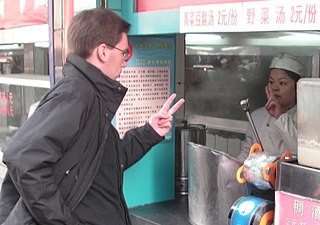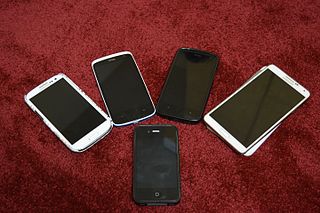Flaming, also known as roasting, is the act of posting insults, often including profanity or other offensive language, on the internet. Flaming is distinct from trolling, which is the act of someone causing discord online or in person. Flaming emerges from the anonymity that Internet forums provide for users and which allow them to act more aggressively. Anonymity can lead to disinhibition, which results in the swearing, offensive, and hostile language characteristic of flaming. Lack of social cues, less accountability of face-to-face communications, textual mediation and deindividualization are also likely factors. Deliberate flaming is carried out by individuals known as flamers, which are specifically motivated to incite flaming. These users specialize in flaming and target specific aspects of a controversial conversation.
Human communication, or anthroposemiotics, is a field of study dedicated to understanding how humans communicate. Humans' ability to communicate with one another would not be possible without an understanding of what we are referencing or thinking about. Because humans are unable to fully understand one another's perspective, there needs to be a creation of commonality through a shared mindset or viewpoint. The field of communication is very diverse, as there are multiple layers of what communication is and how we use its different features as human beings.

Communication theory is a proposed description of communication phenomena, the relationships among them, a storyline describing these relationships, and an argument for these three elements. Communication theory provides a way of talking about and analyzing key events, processes, and commitments that together form communication. Theory can be seen as a way to map the world and make it navigable; communication theory gives us tools to answer empirical, conceptual, or practical communication questions.
Computer-mediated communication (CMC) is defined as any human communication that occurs through the use of two or more electronic devices. While the term has traditionally referred to those communications that occur via computer-mediated formats, it has also been applied to other forms of text-based interaction such as text messaging. Research on CMC focuses largely on the social effects of different computer-supported communication technologies. Many recent studies involve Internet-based social networking supported by social software.

Nonverbal communication (NVC) is the transmission of messages or signals through a nonverbal platform such as eye contact (oculesics), body language (kinesics), social distance (proxemics), touch (haptics), voice (paralanguage), physical environments/appearance, and use of objects. When communicating, we utilize nonverbal channels as means to convey different messages or signals, whereas others can interpret these message. The study of nonverbal communication started in 1872 with the publication of The Expression of the Emotions in Man and Animals by Charles Darwin. Darwin began to study nonverbal communication as he noticed the interactions between animals such as lions, tigers, dogs etc. and realized they also communicated by gestures and expressions. For the first time, nonverbal communication was studied and its relevance questioned. Today, scholars argue that nonverbal communication can convey more meaning than verbal communication.
Impression management is a conscious or subconscious process in which people attempt to influence the perceptions of other people about a person, object or event by regulating and controlling information in social interaction. It was first conceptualized by Erving Goffman in 1959 in The Presentation of Self in Everyday Life, and then was expanded upon in 1967.
Theories of technological change and innovation attempt to explain the factors that shape technological innovation as well as the impact of technology on society and culture. Some of the most contemporary theories of technological change reject two of the previous views: the linear model of technological innovation and other, the technological determinism. To challenge the linear model, some of today's theories of technological change and innovation point to the history of technology, where they find evidence that technological innovation often gives rise to new scientific fields, and emphasizes the important role that social networks and cultural values play in creating and shaping technological artifacts. To challenge the so-called "technological determinism", today's theories of technological change emphasize the scope of the need of technical choice, which they find to be greater than most laypeople can realize; as scientists in philosophy of science, and further science and technology often like to say about this "It could have been different." For this reason, theorists who take these positions often argue that a greater public involvement in technological decision-making is desired.
Media richness theory (MRT), sometimes referred to as information richness theory, is a framework used to describe a communication medium's ability to reproduce the information sent over it. It was introduced by Richard L. Daft and Robert H. Lengel in 1986 as an extension of information processing theory. MRT is used to rank and evaluate the richness of certain communication media, such as phone calls, video conferencing, and email. For example, a phone call cannot reproduce visual social cues such as gestures which makes it a less rich communication media than video conferencing, which affords the transmission of gestures and body language. Based on contingency theory and information processing theory, MRT theorizes that richer, personal communication media are generally more effective for communicating equivocal issues in contrast with leaner, less rich media.

Social information processing theory, also known as SIP, is a psychological and sociological theory originally developed by Salancik and Pfeffer in 1978. This theory explores how individuals make decisions and form attitudes in a social context, often focusing on the workplace. It suggests that people rely heavily on the social information available to them in their environments, including input from colleagues and peers, to shape their attitudes, behaviors, and perceptions.
The hyperpersonal model is a model of interpersonal communication that suggests computer-mediated communication (CMC) can become hyperpersonal because it "exceeds [face-to-face] interaction", thus affording message senders a host of communicative advantages over traditional face-to-face (FtF) interaction. The hyperpersonal model demonstrates how individuals communicate uniquely, while representing themselves to others, how others interpret them, and how the interactions create a reciprocal spiral of FtF communication. Compared to ordinary FtF situations, a hyperpersonal message sender has a greater ability to strategically develop and edit self-presentation, enabling a selective and optimized presentation of one's self to others.
The following outline is provided as an overview of and topical guide to communication:
Media naturalness theory is also known as the psychobiological model. The theory was developed by Ned Kock and attempts to apply Darwinian evolutionary principles to suggest which types of computer-mediated communication will best fit innate human communication capabilities. Media naturalness theory argues that natural selection has resulted in face-to-face communication becoming the most effective way for two people to exchange information.
Social presence theory explores how the "sense of being with another" is influenced by digital interfaces in human-computer interactions. Developed from the foundations of interpersonal communication and symbolic interactionism, social presence theory was first formally introduced by John Short, Ederyn Williams, and Bruce Christie in The Social Psychology of Telecommunications. Research on social presence theory has recently developed to examine the efficacy of telecommunications media, including SNS communications. The theory notes that computer-based communication is lower in social presence than face-to-face communication, but different computer-based communications can affect the levels of social presence between communicators and receivers.

Interpersonal communication is an exchange of information between two or more people. It is also an area of research that seeks to understand how humans use verbal and nonverbal cues to accomplish several personal and relational goals. Communication includes utilizing communication skills within one's surroundings, including physical and psychological spaces. It is essential to see the visual/nonverbal and verbal cues regarding the physical spaces. In the psychological spaces, self-awareness and awareness of the emotions, cultures, and things that are not seen are also significant when communicating.
Joseph B. Walther is the Mark and Susan Bertelsen Presidential Chair in Technology and Society and the Director of the Center for Information Technology & Society at the University of California, Santa Barbara. His research focuses on social and interpersonal dynamics of computer-mediated communication, in groups, personal relationships, organizational and educational settings. He is noted for creating social information processing theory in 1992 and the hyperpersonal model in 1996.
Channel expansion theory (CET) states that individual experience serves as an important role in determining the level of richness perception and development towards certain media tools. It is a theory of communication media perception that incorporates experiential factors to explain and predict user perceptions of a given media channel. The theory suggests that the more knowledge and experience users gain from using a channel, the richer they perceive the medium to be. The more experience, the more stable the knowledge base the person builds, the more knowledge he gains from the given media channel, thus the richer communication he would have using that channel, and ultimately the richer he would perceive the channel. There are four experiential factors that shapes individual's perceived media richness: experience with the channel, experience with the message topic, experience with the organizational context, and experience with a communication partner.
Multi-communicating is the act of managing multiple conversations simultaneously. The term was coined by Reinsch, Turner, and Tinsley, who proposed that simultaneous conversations can be conducted using an array of media, including face-to-face, phone, and email tools for communication. The practice allows individuals to utilize two or more technologies to interact with each other.
Adam N. Joinson is a British author, academic and public speaker within the area of cyberpsychology. He is Professor of Information Systems at University of Bath, following posts at the University of West of England and the Open University. and has conducted ground breaking research into the psychology of Internet usage.
Emotions in virtual communication are expressed and understood in a variety of different ways from those in face-to-face interactions. Virtual communication continues to evolve as technological advances emerge that give way to new possibilities in computer-mediated communication (CMC). The lack of typical auditory and visual cues associated with human emotion gives rise to alternative forms of emotional expression that are cohesive with many different virtual environments. Some environments provide only space for text based communication, where emotions can only be expressed using words. More newly developed forms of expression provide users the opportunity to portray their emotions using images.

Means of communication are used by people to communicate and exchange information with each other as an information sender and an information recipient.




